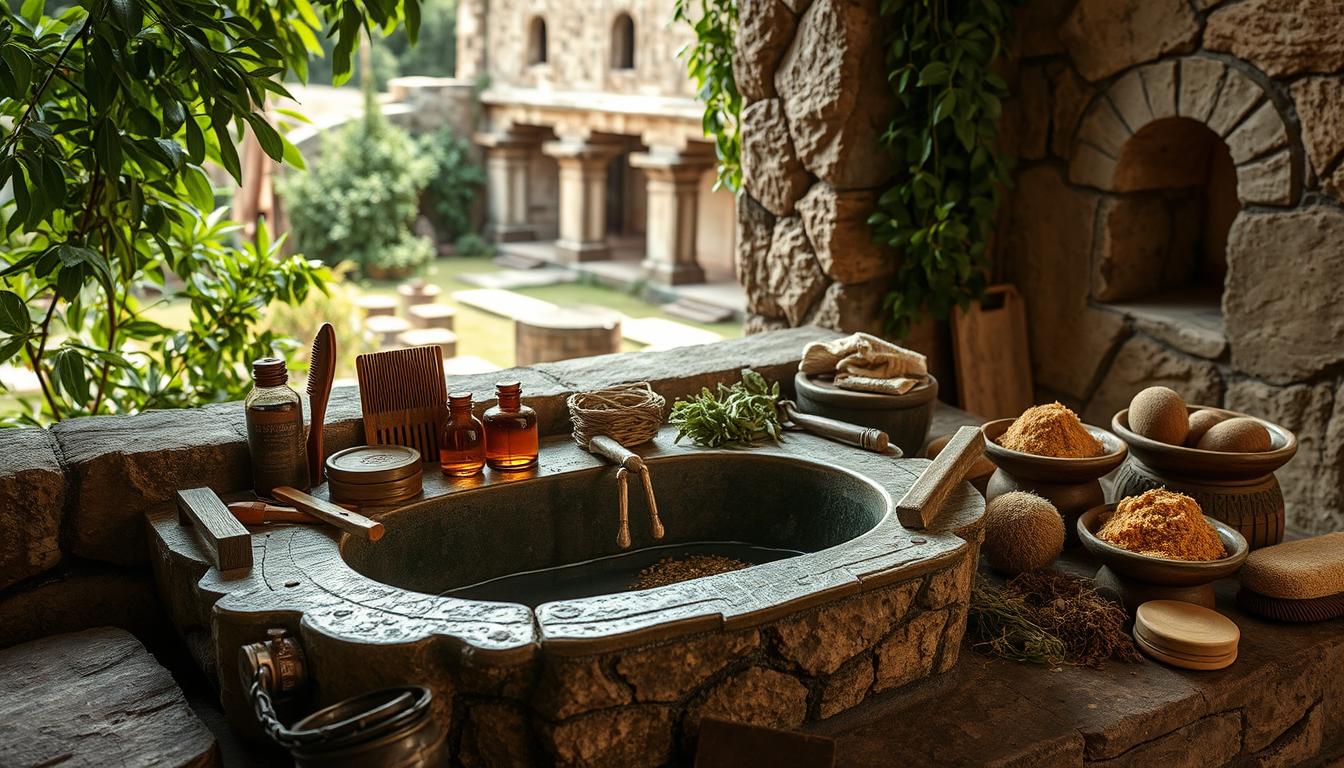Men’s grooming has a long and interesting history. It was more than just looking good; it showed a man’s status and identity. Looking into ancient grooming shows us methods that are surprisingly good today.
Men in ancient times put a lot of effort into their grooming. They used hair oils in Egypt and took care of their beards in Mesopotamia. These old ways often used natural ingredients and methods that science now supports.
Key Takeaways
- Natural ingredients were central to ancient grooming practices
- Grooming was closely tied to cultural and social expectations
- Many ancient techniques remain relevant in contemporary personal care
- Traditional methods often used sustainable, organic materials
- Personal hygiene was considered a mark of respect and social standing
Ancient Egyptian Oils and Unctions
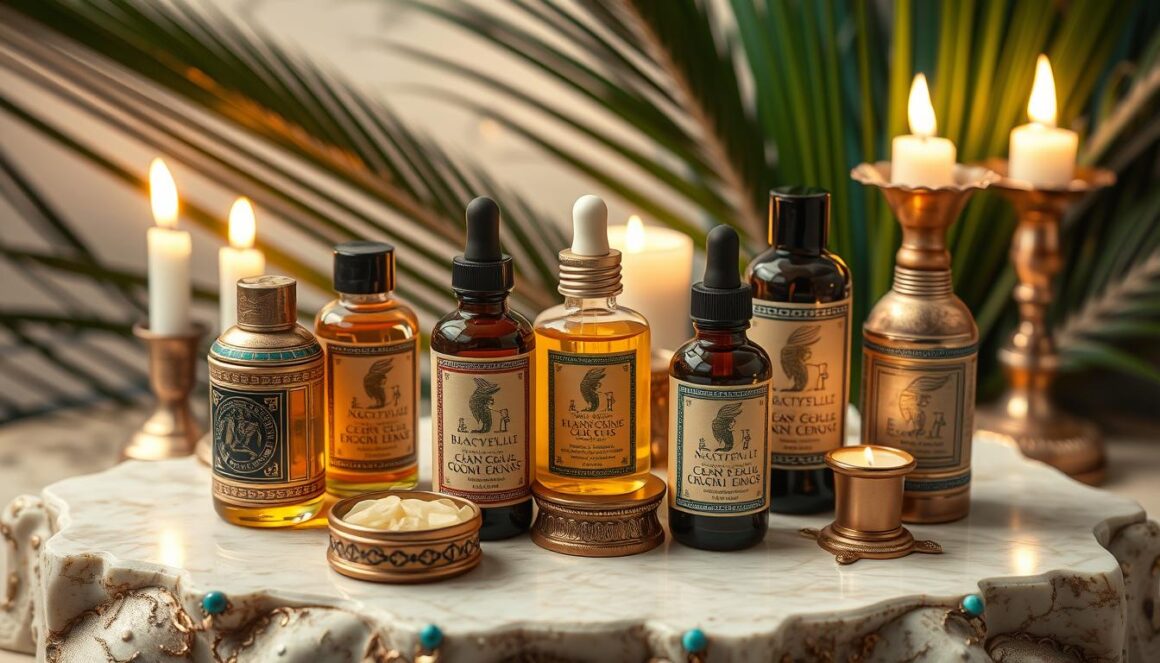
Ancient Egyptian men were true pioneers in beauty. They turned simple grooming tools into works of art. Their care routine was not just about cleanliness but also had deep spiritual meaning.
They used oils from almonds, moringa, and castor plants for many reasons. These oils protected their skin from the desert and made them look better. The rich used gold razors, showing grooming was a sign of status.
Their beauty traditions were very detailed. Priests shaved every other day for purification. Kings had special barbers with fancy razors, showing grooming’s importance.
Natural oils were key in their skincare. Almond oil kept skin moist, and moringa oil fought off germs. These oils were more than beauty products; they were part of their health and spiritual life.
Today, we can learn from their skincare. The Egyptians’ focus on natural ingredients and holistic care inspires us. Their beauty routines are timeless.
Roman Bathing Rituals
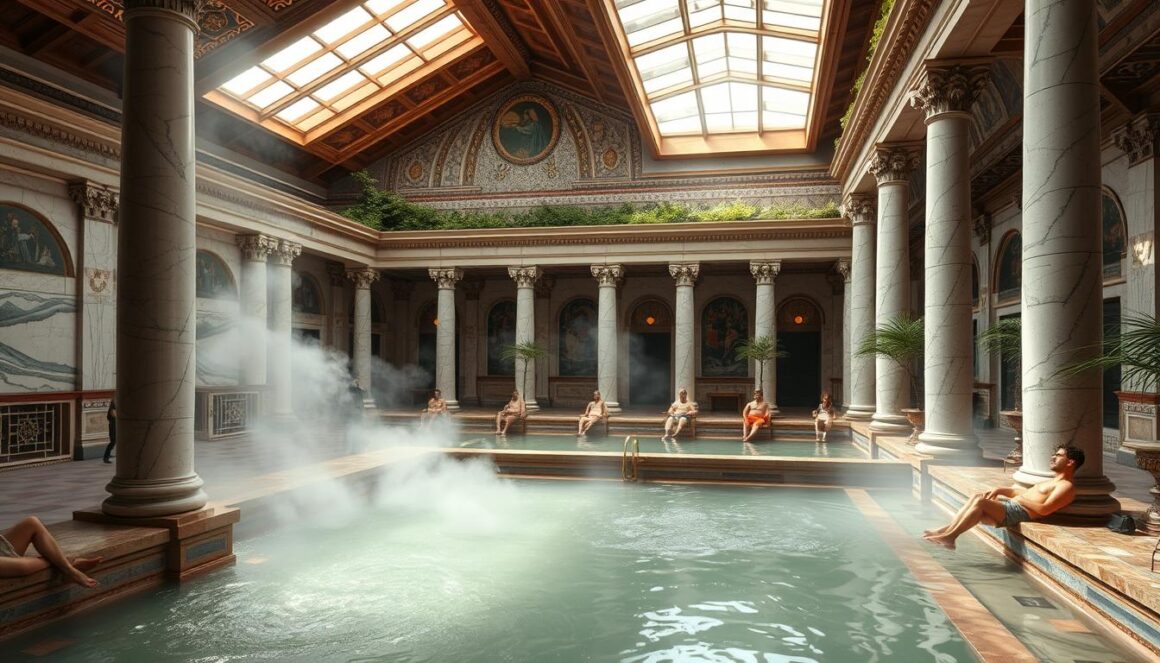
Ancient Roman men turned grooming into an art form through their bathing rituals. Public baths were not just for cleaning. They were social centers where men learned hairstyling and kept themselves clean with great care.
The Roman bathing process was detailed and showed their dedication to grooming. Men went through different temperatures, from warm to cold. They used a strigil, a metal tool, to clean their skin after bathing.
There were over 1,000 public baths in Rome in the first century A.D. These baths were open to most people, with prices from free for kids to a quarter for men. Rich Romans spent a lot on scented oils and grooming, making baths a luxury.
Daily bathing was common in Rome. People washed their arms and legs often and bathed fully once a week. Even emperors like Commodus bathed up to eight times a day, showing how important cleanliness was.
The Romans saw bathing as more than just cleaning. It was a ritual that combined socializing, personal care, and cultural identity. Their detailed grooming practices inspire us today, showing the long history of self-care.
Ancient Greek Hair Care Techniques
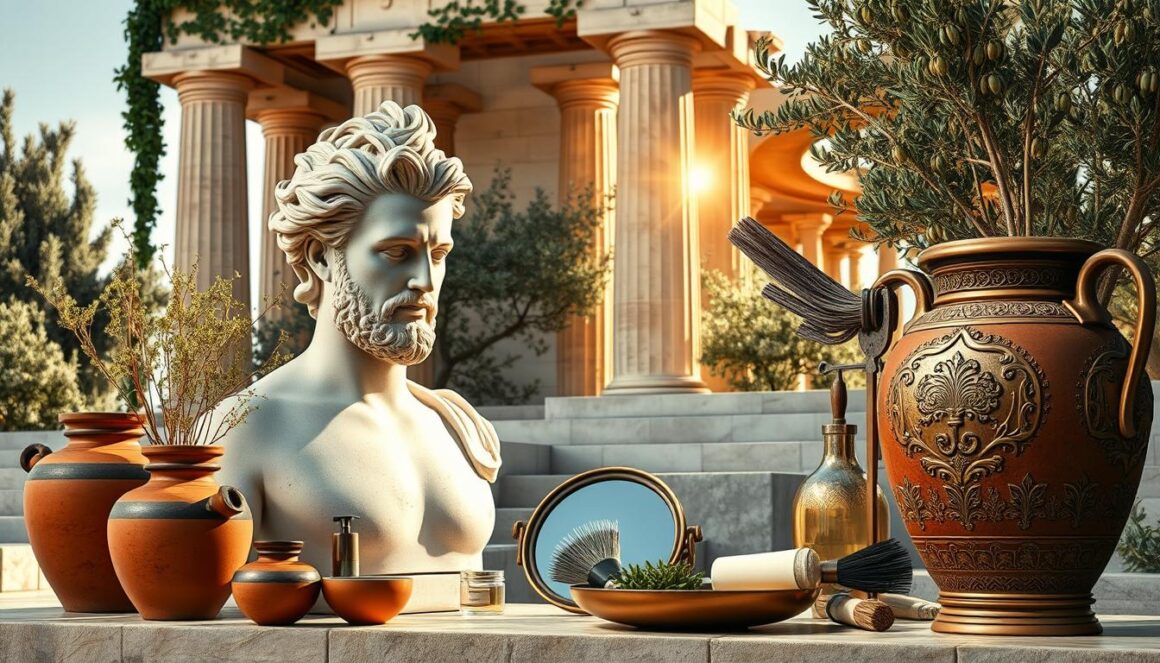
Ancient Greeks turned prehistoric skincare into a fine art of grooming. They took hair care to new heights, making it a symbol of elegance and precision.
Olive oil was key in Greek hair care. Men would massage it into their scalps, creating a deep conditioning effect. This showed their understanding of hair care long before today’s products.
The Greeks used tools like the calamistrum, an early curling iron, for fancy hairstyles. Hairstyles showed a man’s status and identity. Barbers were highly respected for their skills in cutting and styling hair.
Herbal infusions were also important in their hair care. They mixed rosemary, chamomile, and other herbs for strong and beautiful hair. This showed their dedication to natural, holistic care.
Today, we can learn from these ancient methods. Using oils, natural ingredients, and taking care of our hair can improve our grooming. It connects us to a long history of hair care wisdom.
Beard Grooming in Mesopotamia
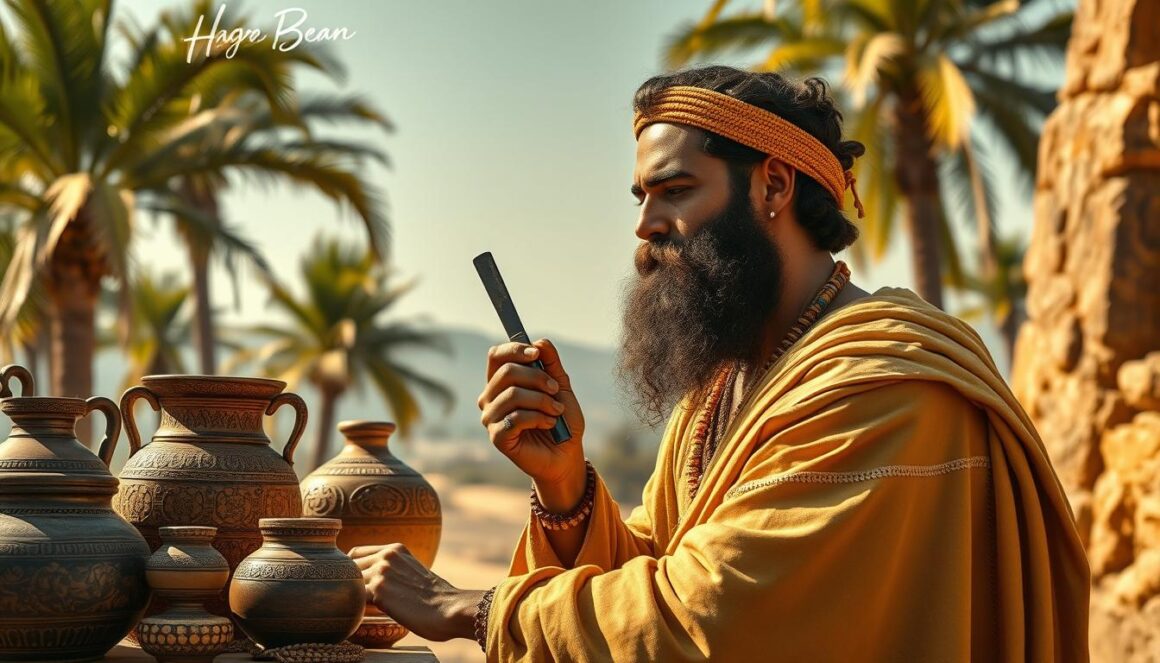
Mesopotamian men saw grooming as an art. They believed facial hair showed their status and masculinity. Metal combs were key for keeping their beards in style, showing their place in society.
Beard care in Mesopotamia was more than just keeping it clean. The rich wore braids and pins in their beards. They used oils from plants to keep their hair soft and shiny. The length and thickness of a beard showed a man’s wealth and status.
Beard styles told a man’s job. Merchants had neat beards, while warriors had wild ones. Priests and nobles were proud of their well-groomed beards, using special tools to shape them.
Mesopotamian grooming shows a deep understanding of personal care. They used cedar oil and other natural extracts to keep their beards healthy. These ancient methods inspire many modern grooming practices today.
Indian Ayurvedic Skincare
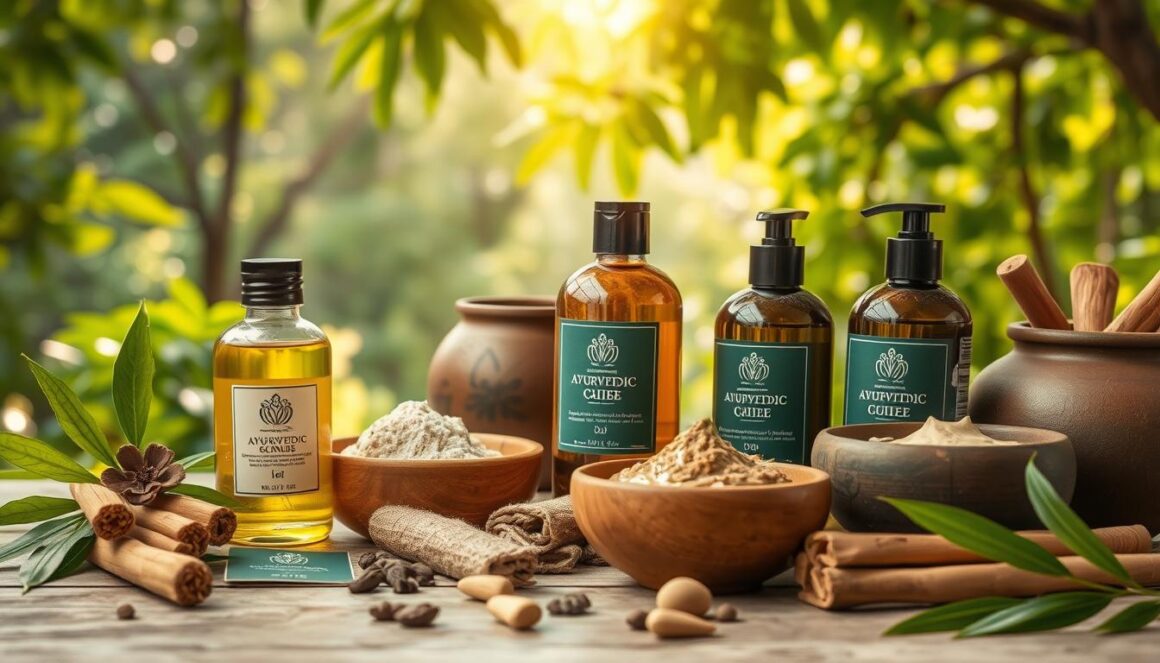
Ayurvedic skincare is a key part of ancient cosmetics, giving men skincare routines from thousands of years ago. This ancient Indian healing system offers holistic ways to care for the skin that are just as good today.
The Ayurvedic method knows that men’s skin needs special care. Men’s skin is usually thicker and makes more oil, so these old tools tackle specific skin problems. It sorts skin into Vata, Pitta, and Kapha types, helping tailor skincare plans.
Natural ingredients are key in Ayurvedic skincare. Ingredients like neem, turmeric, and sandalwood offer great benefits for the skin. They help with oiliness, acne, and damage from the environment. Today, 70% of Indian men use Ayurvedic products in their routines.
Modern men can start using Ayurvedic skincare easily. They can eat well, sleep enough, and use natural products. The Ayurvedic skincare market is expected to grow to Rs. 30,000 crore by 2025, showing more people trust these ancient methods.
By using Ayurvedic skincare, men can tap into ancient wisdom. This wisdom helps not just look good but also feel well and healthy overall.
Japanese Samurai Hair Maintenance
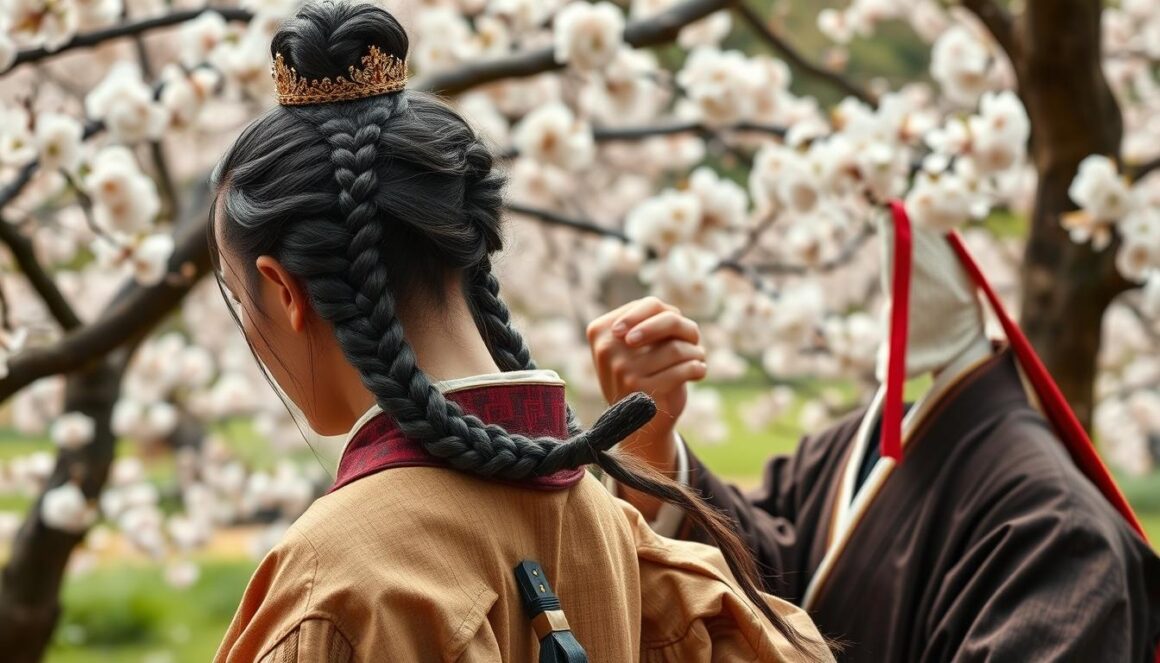
The early hairstyling techniques of Japanese samurai were complex, not just simple hair care. They saw their hair as a sign of discipline and status. The chonmage hairstyle became a symbol of traditional male grooming in feudal Japan.
Samurai spent a lot of time on their hair, up to 20% of their day. Natural oils were key in their grooming routines. Camellia oil, rich in oleic acid, kept their hair healthy and shiny. Wooden combs helped spread these oils evenly.
For samurai, a neat hairstyle showed inner strength and discipline. They used handmade combs and natural ingredients for their look. The chonmage was more than a hairstyle; it was a statement of pride and identity.
Today, men can learn from samurai grooming. Using natural oils, quality combs, and a regular grooming routine can elevate hair care. The samurai’s approach to hair continues to shape modern male grooming.
Celtic Practices for Body Cleanliness
The ancient Celtic tribes had advanced hygiene practices. They went beyond just washing. Their grooming rituals focused on both body and spirit.
Celtic warriors followed strict hygiene rules. Laws guided how often they bathed and cared for themselves.
Celtic men used nature for their skincare. Hot springs and steam baths were key. They used herbs like meadowsweet and heather for their skin.
They had special tools like bone combs and ear spoons. These showed their advanced grooming skills.
Hairstyling was big in Celtic culture. Warriors and nobles spent a lot of time on their hair. They used braids and even dyed their hair red.
Higher-class warriors kept clean even when fighting. They saw cleanliness as key to spiritual health. They bathed regularly as part of their daily routine.
Today, we can learn from the Celts. We can use natural cleansers and herbal remedies. Keeping up with grooming routines is important.
Conclusion – Ancient Men’s Grooming Routines That Actually Work Today
Ancient men’s grooming routines show a deep link between personal care and culture. These routines have lasted for thousands of years, giving us valuable lessons today. From ancient Egyptian razors to Indian herbal treatments, these methods prove that good skincare doesn’t need modern tech.
Men’s beauty traditions have changed a lot, but the basics stay the same. Today, we see a mix of old and new in grooming. Brands now use natural ingredients and focus on health, inspired by ancient wisdom.
Modern men can learn a lot from these old grooming practices. By using natural ingredients and seeing grooming as a ritual, we can improve our routines. It’s about mixing old wisdom with new knowledge about skin and hair.
Today, grooming trends celebrate different cultures and styles. Men can try everything from Egyptian scents to Japanese precision. This shows that the best ideas often come from ancient traditions.

